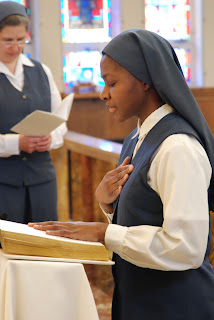 |
| Br. Peter Lyne, SSP |
One event will take place April 3 in New York City with 1,500 officers of the NYPD and their spouses. The other will be a family barbeque on Staten Island on June 25, ending with the sung novena to St. Paul, whose feast occurs a few days later. At each event we will party, of course (!), and will also talk for a few minutes about our charism, that is, the gift of the Holy Spirit given to the Pauline Family for building up the Church, the Body of Christ. Each event will include a showing of the preview and an opportunity for interested people to discover more.
In the course of our planning two days ago, Br. Peter, Irish-American as they come, told me stories about his experience of Pauline religious life (I’ll never tell) and waxed eloquent about what moves him about his consecration. He graciously answered a few of my questions for Pauline Faithways—and those I gladly share:
PF: What motivates you to collaborate as generously as you do on this project, other than the obvious little detail that Fr. Alberione is your founder too?
BPL: It’s very personal. Not only do I consider him our founder, but one of the greatest privileges of my life was the day I met a saint. It was brief; I was a novice. It was like a Dominican meeting Dominic, a Franciscan or Jesuit meeting Francis or Ignatius.
When we come in the presence of great men and women of the Church, it is a powerful experience. Their sanctity is our spiritual inheritance. The example of how they pursued holiness remains with us until the day we go home to God. That carries us through everything in life.
PF: So you see in the story of this great man of the Church a chance for people to have the same experience that you had?
BPL: Exactly. We don’t have to be in the presence of the person to have that experience. When any of us view a film, a documentary, or a newscast, even if we’ve never met the people personally, the documentary gives us a sense that we have met them. Their message, their words, their life somehow affect us.
PF: What aspect of the founder’s life or heritage inspires you the most?
BPL: His sense of determination and perseverance. In the midst of certain encounters and of trying to form this apostolic endeavor [of beginning the Pauline Family], the founder was persistent as well as persevering. He might have felt sorrow or disappointment, but his faith and trust in God made him determined to work for the honor and glory of God, the good of the Church, and the good of humanity.
PF: What are your hopes for this film?
BPL: That as many people as possible—Catholic and non-Catholic—will see this and be edified by the saint of the media.
Everyone is more media savvy than they were thirty or forty years ago. They need to see the Church there too. People usually see the Church as a building, with its schools and institutions, but the Church is so much more than that. They need to learn more about its activity and about the Church’s interest in communication as a vehicle for preaching the Gospel. They need to see that there are congregations that minister by way of communications.
 |
| Br. Peter, SSP, Jas. Haynes III, Hibernians, Sgt. Brian Reilly, Knights of Columbus & NYPD, Maria Haynes and husband James IV, both Hibernians. I'm the photographer. |
PF: What message would you like to give to prospective or repeat donors of this project?
BPL: So much money is spent on media in all its forms—computers, iPhones, iPads, TVs. Donors would help the Pauline Family to invest in one of the greatest projects of the Pauline Family—this film.
By involving donors and benefactors in this way, I think that all the members of the Pauline Family deeply and sincerely invite the laity of the Church to join with us arm in arm, hand in hand, side by side. Evangelization is not the work only of priests, brothers, and sisters, ordained and consecrated. Blessed James wanted the laity to be a part of “us.” Together we can do so much!
We’re working within a $100,000 budget and have raised almost $38,000 so far. If you’d like to outshine New York (Is that possible?) and contribute to this documentary before they do, go to http://www.alberionefilm.com/ to send a check or donate securely online. May Blessed James Alberione join his prayers to yours!




